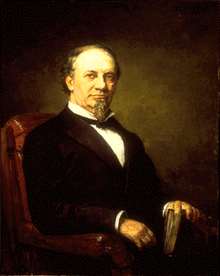Isaac P. Gray
| Isaac P. Gray | |
|---|---|

Isaac P. Gray, 1888 portrait, by Theodore C. Steele
|
|
| 20th Governor of Indiana | |
|
In office January 12, 1885 – January 14, 1889 |
|
| Lieutenant |
Mahlon D. Manson Alonzo G. Smith (acting) |
| Preceded by | Albert G. Porter |
| Succeeded by | Alvin P. Hovey |
| 18th Governor of Indiana | |
|
In office November 20, 1880 – January 10, 1881 |
|
| Lieutenant | Fredrick Vieche (acting) |
| Preceded by | James D. Williams |
| Succeeded by | Albert G. Porter |
| 18th Lieutenant Governor of Indiana | |
|
In office January 13, 1877 – November 2, 1880 |
|
| Governor | James D. Williams |
| Preceded by | Leonidas Sexton |
| Succeeded by |
Fredrick Vieche as Acting Lieutenant Governor |
| Member of the Indiana Senate | |
|
In office 1870–1874 |
|
| Personal details | |
| Born | October 18, 1828 Chester County, Pennsylvania |
| Died | February 14, 1895 (aged 66) Mexico City, Mexico |
| Political party |
Whig Republican (1865–1876) Democrat (1876–1895) |
| Spouse(s) | Eliza Jaqua Gray |
| Religion | Quaker |
Isaac Pusey Gray (October 18, 1828 – February 14, 1895) was the 18th and 20th Governor of the U.S. state of Indiana from 1880 to 1881 and from 1885 to 1889. Originally a Republican, he oversaw the forceful passage of the post-American Civil War constitutional amendments whilst he was a member of the Indiana Senate. He became a Democrat following the corruption of the Administration of Ulysses S. Grant but was regularly stymied by his Democratic adversaries who constantly referred to his tactics while a Republican, earning him the nickname "Sisyphus of the Wabash."
Issac Pusey Gray was born on October 18, 1828 in Chester County, Pennsylvania, the son of John and Hannah Worthington Gray, two Quaker innkeepers. At age eight, his family moved to Urbana, Ohio and in 1842 to New Madison, Ohio. In New Madison, Gray first attended common school and obtained some formal education. After school he became a clerk in a dry-goods store, and later became the owner of the store after purchasing it from his former boss. He married to Eliza Jaqua on September 8, 1850, and the couple had four sons. Two of them died in infancy, but the other two grew up to become lawyers.
Gray and his family moved to Union City, Indiana in 1855 where he opened a new store. He soon became involved in local politics and became prominent in his community. He began to study law on his own in his spare time and was admitted to the bar in 1861. He later said that he studied law to further his political career, which was very important in Indiana politics at that time.
Only a month after he opened a law office the American Civil War began, and Gray set out to raise a company of volunteers. He entered the Union army as a Colonel and given command of the 4th Regiment Indiana Cavalry in the fall of 1862. He led his regiment against forces under Confederate General John Hunt Morgan near Munfordville, Kentucky in December 1862. He served for about a year before resigning from the army after being denied a promotion.
...
Wikipedia
